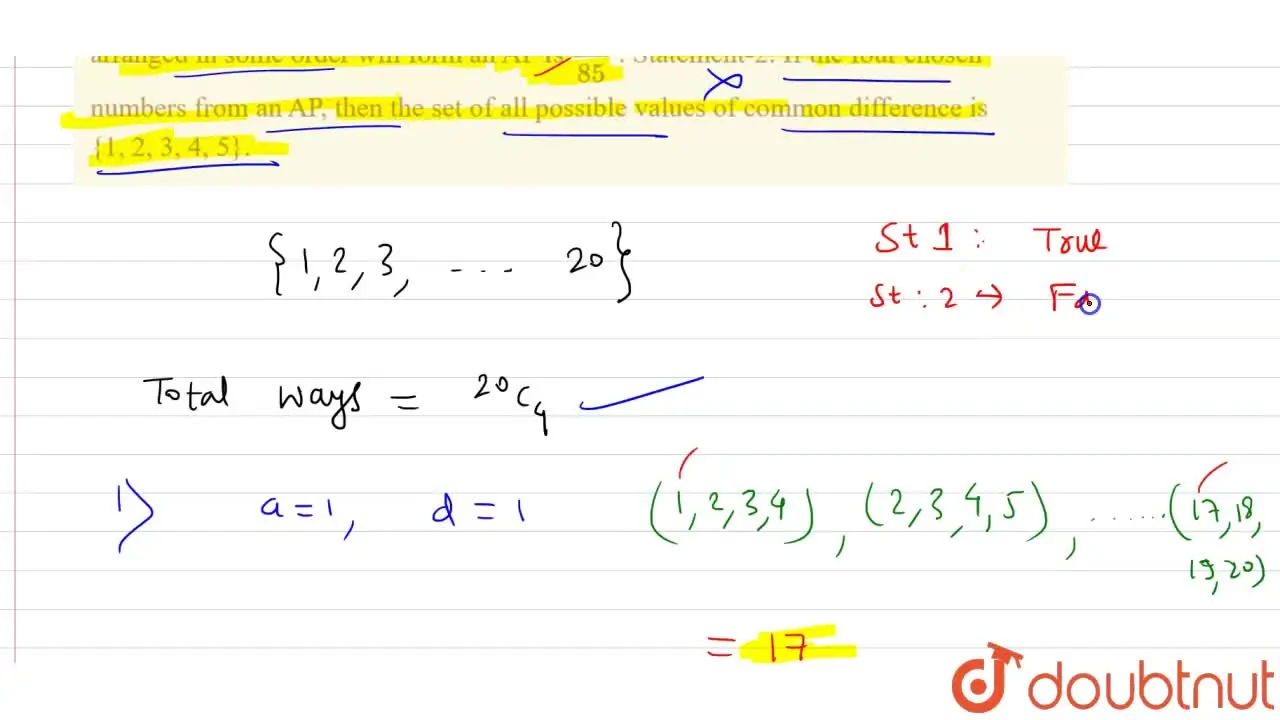Four numbers are chosen at random (without replacement) from the set {1, 2, 3, ....., 20}. Statement-1: The probability that the chosen numbers when arranged in some order will form an AP Is 185 . Statement-2: If the four chosen numbers from an AP, then the set of all possible values of common difference is {1, 2, 3, 4, 5}. (1) Statement-1 is true, Statement-2 is true; Statement-2 is not the correct explanation for Statement-1 (2) Statement-1 is true, Statement-2 is false (3) Statement-1 is false, Statement-2 is true (4) Statement-1 is true, Statement-2 is true; Statement-2 is the correct explanation for Statement-1
Statement-1 is True, Statement-2 is True, Statement-2 is a correct explanation for Statement-1.
Statement-1 is True, Statement-2 is True, Statement-2 is not a correct explanation for Statement-1.
Statement-1 is True, Statement-2 is False.
Statement-1 is False, Statement-2 is True.
The correct Answer is:C
Total number of ways of selecting 4 numbers out of first 20 natural numbers = .20C4 .
Number of A.P with common differenece 1 is =17
(1 ,2,3,4,, 2,3,4,5 ,….., , 17 ,18,19,20)
Number of A.P's with common differen 2 is =14
( 1,3,5,7,, 2,4,6,8,..., 14,16,18,20)
number of A,P s with common difference 2 is 14
Number of A.P's with common differen 3 is =11
( 1,4,7,10, 2,5,8,11 ,...., 11,14,17,20) and soon.
The maximum common difference can be 6 and the number of such A.P 's is = 2
( 1,7,13,19, 2,8, 14,20)
Total number of ways in which chosen numbers are in A.p
17 + 14 +11 + .....+ 2=57
Propbability than the chosen numbers are in AP
5720C4=185
Clearly, the set of all possible values of common difference is
{±1,±2,±3,±4,±5,±6}
So, statement -2 is not true.
Related Playlists
- BOOK - OBJECTIVE RD SHARMACHAPTER - PROBABILITY EXERCISE - Section I - Mcqs94videos
PROBABILITY
- BOOK - OBJECTIVE RD SHARMACHAPTER - PROBABILITY EXERCISE - Section II - Assertion Reason Type22videos
PROBABILITY
- BOOK - OBJECTIVE RD SHARMACHAPTER - PROBABILITY EXERCISE - Section I - Solved Mcqs126videos
PROBABILITY
- BOOK - OBJECTIVE RD SHARMACHAPTER - PERMUTATIONS AND COMBINATIONSEXERCISE - Chapter Test60videos
PERMUTATIONS AND COMBINATIONS
- BOOK - OBJECTIVE RD SHARMACHAPTER - QUADRATIC EXPRESSIONS AND EQUATIONS EXERCISE - Chapter Test50videos
QUADRATIC EXPRESSIONS AND EQUATIONS
Similar Questions
Three numbers are chosen at random (without replace ment) from the numbers 1, 2,... 20. The probability that the numbers are not consecutive are
View SolutionLet f: R R be a continuous function defined by f(x)=1ex+2e−x . Statement-1: f(c)=13, for some c∈R . Statement-2: 0<f(x)≤12√2, for all x∈R . (1) Statement-1 is true, Statement-2 is true; Statement-2 is not the correct explanation for Statement-1 (2) Statement-1 is true, Statement-2 is false (3) Statement-1 is false, Statement-2 is true (4) Statement-1 is true, Statement-2 is true; Statement-2 is the correct explanation for Statement-1
View SolutionThree numbers are chosen at random without replacement from {1,2,3,....10}. The probability that the minimum of the chosen number is 3 or their maximum is 7 , is:
View SolutionStatement-1: The point A(3, 1, 6) is the mirror image of the point B(1, 3, 4) in the plane xy+z=5 . Statement-2: The plane x xy+z=5 bisects the line segment joining A(3, 1, 6) and B(1, 3, 4). (1) Statement-1 is true, Statement-2 is true; Statement-2 is not the correct explanation for Statement-1 (2) Statement-1 is true, Statement-2 is false (3) Statement-1 is false, Statement-2 is true (4) Statement-1 is true, Statement-2 is true; Statement-2 is the correct explanation for Statement-1
View SolutionThree numbers are chosen at random without replacement from {1,2,3,....10}. The probability that the minimum of the chosen number is 3 or their maximum is 7 , is P then 20P is
View SolutionThree numbers are chosen at random without replacement from {1, 2, 3, ...... 8}. The probability that their minimum is 3, given that their maximum is 6, is (1) 38 (2) 15 (3) 14 (4) 25
View SolutionThree numbers are chosen at random without replacement from {1, 2, 3, ...... 8}. The probability that their minimum is 3, given that their maximum is 6, is (1) 38 (2) 15 (3) 14 (4) 25
View SolutionThree numbers are chosen at random without replacement from {1,2,…..8} the probability that their minimum is 3 given that their maximum is 6 is
View SolutionTwo numbers b and c are chosen at random with replacement from the numbers 1, 2, 3, 4, 5, 6, 7, 8 and 9. The probability that x2+bx+c>0forallξnR, is
View SolutionTwo numbers b and c are chosen at random with replacement from the numbers 1,2,3,4,5,6,7,8and9. The probability that x2+bx+c>0 for all x∈R is
View Solution


